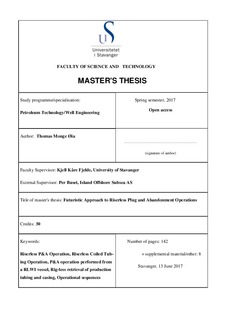| dc.contributor.advisor | Fjelde, Kjell Kåre | |
| dc.contributor.author | Øia, Thomas Monge | |
| dc.coverage.spatial | Norway | nb_NO |
| dc.date.accessioned | 2017-10-24T12:50:58Z | |
| dc.date.available | 2017-10-24T12:50:58Z | |
| dc.date.issued | 2017-06-13 | |
| dc.identifier.uri | http://hdl.handle.net/11250/2461857 | |
| dc.description | Master's thesis in Petroleum engineering | nb_NO |
| dc.description.abstract | On the Norwegian Continental Shelf (NCS) today, there are 1033 subsea wells that are classified with the status online/operational, Drilling, Predrilled, Suspended and Closed[1] and these subsea wells will have to be permanently plugged and abandoned (PP&A) at some point. When the revenue of these subsea wells decreases and the cost is the driving factor, we are left with two options; permanently plug the reservoir section and reuse the slot by drilling a sidetrack or PP&A the subsea well.
P&A operations is associated with high cost for the operating companies, licensees and the Norwegian taxpayers. To maintain the production on the NCS, one have to drill new wells to ensure new discoveries. However, as new wells are drilled others have to be PP&A. By using a riserless light well intervention (RLWI) vessel to conduct P&A operations, one can exclude the use of expensive mobile offshore drilling units (MODUs) and consequently maintain the drilling activity on the NCS.
The current practice is to use a semi-submersible rig with marine riser to perform the res-ervoir – and intermediate abandonment. By utilizing the current practice and convert it to the new concept of conducting PP&A from a RLWI vessel, we could find the technology gap and the best suited subsea well candidates. The intention is to perform full riserless P&A operations using wireline, coiled tubing and main winch (i.e. a rig-less approach) combined with additional equipment. A large proportion of the current and future subsea wells on the NCS and in the rest of the world will be potential candidates for riserless PP&A with a RLWI vessel. Riserless P&A operations of subsea wells with low well abandonment complexity will most likely reduce the overall P&A expenditures because RLWI vessels has a lower day rate and an effective method of performing the P&A operation.
The objective of this thesis is to identify the RLWI vessel’s potential to perform full riserless P&A operations and present its operational boundaries with respect to well abandonment complexity. A description of available and required technology is also given. Three individual base cases with increasing complexity containing operational sequences and well barrier schematics will be presented to show application of existing and required technology and to identify the main challenges. | nb_NO |
| dc.language.iso | eng | nb_NO |
| dc.publisher | University of Stavanger, Norway | nb_NO |
| dc.relation.ispartofseries | Masteroppgave/UIS-TN-IPT/2017; | |
| dc.subject | petroleumsteknologi | nb_NO |
| dc.subject | boreteknologi | nb_NO |
| dc.subject | petroleum engineering | nb_NO |
| dc.subject | well engineering | nb_NO |
| dc.title | Futuristic Approach to Riserless Plug and Abandonment Operations | nb_NO |
| dc.type | Master thesis | nb_NO |
| dc.subject.nsi | VDP::Teknologi: 500::Berg‑ og petroleumsfag: 510::Petroleumsteknologi: 512 | nb_NO |
